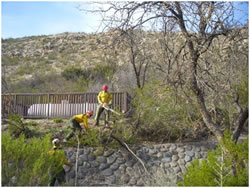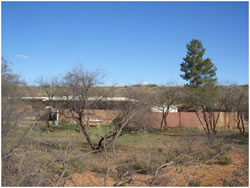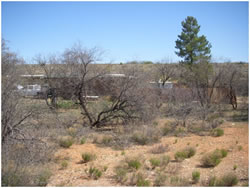National Cohesive Wildland Fire Management Strategy Success Story
Defensible Space Created at Montezuma Castle and Tuzigoot
Montezuma Castle and Tuzigoot National Monuments, Arizona
Cohesive Strategy – Fire-Adapted Human Communities
2012

Module members clearing brush away from a 250-gallon propane tank near the visitor center at Montezuma Castle National Monument.

Pre-treatment (above) and post-treatment (below) at Tuzigoot National Monument.

In 2011, the Zion Wildland Fire Module (WFM) conducted hazard assessments of park structures and infrastructure within Montezuma Castle, Montezuma Well and Tuzigoot National Monuments. The purpose of the project was to implement Firewise principles and create defensible space to help protect park administrative buildings, housing, and infrastructure from wildfires in the future.
The Zion WFM began removing hazardous fuels within 30 feet of park structures and infrastructures. They cleared debris from roofs, gutters, and decks and removed dead or dying vegetation adjacent to or overhanging structures. In addition, they removed or isolated flammable ground cover including leaf litter, woody debris and highly flammable vegetation. They also cut dead or dying grass to less than four inches.
In 2012, the Saguaro WFM, Saguaro fire management staff, and three Student Conservation Association personnel followed up with maintenance to the previous work and extended the fuel reduction to approximately 100 feet around buildings and infrastructure.
They cleared brush and mesquite trees from the Montezuma Castle housing/administrative area and the visitor center, including around power poles, wooden fences, historic adobe structures, and the amphitheater. They also weed-whacked grass and raked leaves where necessary. Two acres were treated. They focused on breaking up continuous fuels and clearing ladder fuels. The debris was piled in a wind row-lined fashion in preparation for chipping. Local contractors later chipped the thinned tree branches and other vegetation for use as mulch on park trails.
Fire personnel also thinned two acres at the historic Montezuma Well site. The crew worked mainly around the maintenance building and residential housing next to it. They improved and widened defensible space between the rear of the housing area and an irrigation ditch, including reducing ladder fuels. Minor work was also done around the ranger station by the Well trailhead.
Fire personnel also treated one acre at Tuzigoot National Monument. They thinned and limbed mesquite and removed brush around the housing/office and maintenance areas.
The work at all three sites reduced and broke up hazardous fuels, mitigated risk for visitors, employees, and infrastructure, and economically used cut materials to improve trail durability and reduce visitor impacts.
Contact: Jason Thievner, Saguaro Wildland Fire Module Leader, Jason_Thievner@nps.gov, (520)733-5167
Keywords: Youth Involvement, Volunteerism, and Employment; America’s Great Outdoors; Woody Biomass Utilization, Cost Effectiveness and Efficiencies